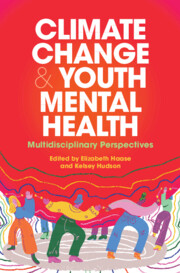Book contents
- Climate Change and Youth Mental Health
- Climate Change and Youth Mental Health
- Copyright page
- Contents
- Figures
- Tables
- Textboxes
- Contributors
- Preface and Introduction
- Considerations
- Acknowledgments
- Part I Conceptual Foundations of Climate Distress in Young People
- Chapter 1 Climate Distress among Young People
- Chapter 2 Definitions and Conceptualizations of Climate Distress
- Chapter 3 Psychiatric Perspectives on Youth Climate Distress
- Chapter 4 Developmental Perspectives on Understanding and Responding to Mental Health Impacts of Climate Change on Young People
- Chapter 5 Neuropsychiatric Perspectives on the Biology of Anxiety and Youth Climate Distress
- Chapter 6 Psychoanalytic and Relational Perspectives on Youth Climate Distress
- Chapter 7 Understanding the Role of Trauma and Dissociation in Youth Responses to Climate Crises
- Chapter 8 Cognitive Behavioral Principles for Conceptualizing Young People’s Eco-Emotions and Eco-Distress
- Chapter 9 A Research Agenda for Young People’s Psychological Response to Climate Change
- Part II Multidisciplinary Perspectives on Youth Climate Distress
- Appendix A Resource List for Educators
- Appendix B Costs and Benefits of Activism Scale
- Index
- References
Chapter 4 - Developmental Perspectives on Understanding and Responding to Mental Health Impacts of Climate Change on Young People
from Part I - Conceptual Foundations of Climate Distress in Young People
Published online by Cambridge University Press: 06 June 2024
- Climate Change and Youth Mental Health
- Climate Change and Youth Mental Health
- Copyright page
- Contents
- Figures
- Tables
- Textboxes
- Contributors
- Preface and Introduction
- Considerations
- Acknowledgments
- Part I Conceptual Foundations of Climate Distress in Young People
- Chapter 1 Climate Distress among Young People
- Chapter 2 Definitions and Conceptualizations of Climate Distress
- Chapter 3 Psychiatric Perspectives on Youth Climate Distress
- Chapter 4 Developmental Perspectives on Understanding and Responding to Mental Health Impacts of Climate Change on Young People
- Chapter 5 Neuropsychiatric Perspectives on the Biology of Anxiety and Youth Climate Distress
- Chapter 6 Psychoanalytic and Relational Perspectives on Youth Climate Distress
- Chapter 7 Understanding the Role of Trauma and Dissociation in Youth Responses to Climate Crises
- Chapter 8 Cognitive Behavioral Principles for Conceptualizing Young People’s Eco-Emotions and Eco-Distress
- Chapter 9 A Research Agenda for Young People’s Psychological Response to Climate Change
- Part II Multidisciplinary Perspectives on Youth Climate Distress
- Appendix A Resource List for Educators
- Appendix B Costs and Benefits of Activism Scale
- Index
- References
Summary
Climate change is already harming the health and well-being of children across the world. In this chapter, we emphasize the need to go beyond the focus on negative psychological responses to climate change and consider its much broader impacts on psychological health – including increasing rates of psychiatric disorders – that overwhelmingly have their origins early in life. This requires taking a developmental life course perspective. Viewed in this way, we show that climatic stressors can affect healthy development from conception onwards by operating with additive, interactive and cumulative developmental effects to increase mental health vulnerability across the life course. In the second part of the chapter, we discuss issues of measurement and emphasize the value of employing longitudinal and multimethod approaches. We conclude with a discussion of adaptation and response planning in the context of current global inequities.
Keywords
- Type
- Chapter
- Information
- Climate Change and Youth Mental HealthMultidisciplinary Perspectives, pp. 70 - 92Publisher: Cambridge University PressPrint publication year: 2024

